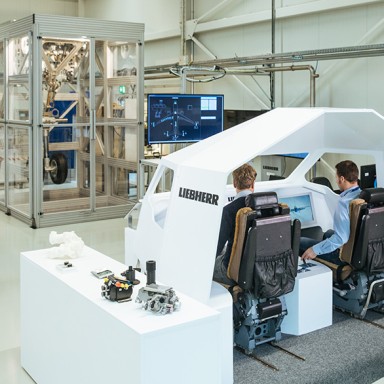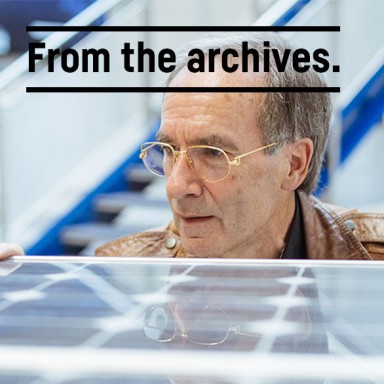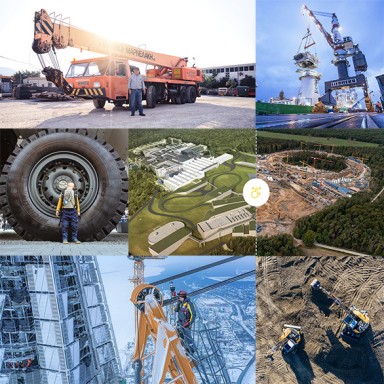
11 minutes reading time
Chasing the cold
Refrigeration technology is everywhere: in the home, in supermarkets, in the office, in manufacturing, in museums or in operating theatres,. It provides the latest in precision control; from ambient comfort and fresh food through to cold storage and super-freezing for sensitive, life-saving medical products and vaccines. And day after day, it helps fulfil one of humanity’s most long-held dreams.
Blowing hot and cold
“For Heat and Cold are Nature’s two hands, whereby she chiefly worketh; and Heat we have in readiness, in respect of the Fire. But for Cold, we must stay till it cometh, or seek it in deep Caves, or high Mountains; and when all is done, we cannot obtain it in any great degree.” English philosopher and statesman Sir Francis Bacon (1561-1629) summed up the dilemma of the pre-industrial age: cold is simply impossible to grasp. Perhaps because it doesn’t actually exist? In physical terms, cold is in fact heat – or rather the absence of heat or, to put it more simply, a state that is lower than the ambient temperature.
Even the early hunter-gatherers knew that lowering the temperature could make life a lot easier and more agreeable. They began preserving perishable food not only by drying and curing it, but also by keeping it in cool caves or holes in the ground, thus paving the way for their transition to a settled lifestyle.
Ice was a hot commodity in classical antiquity and the Middle Ages. People who could afford it dug deep into their pockets to store natural ice carved from glaciers and lakes in deep pits and cellars during the winter, so that it could be consumed bit by bit during the summer months.
The cold rush
In those places where ice was within reach, people often went to great lengths to transport it to cold storage rooms. Once the basic concept had been grasped, a broad variety of culinary delights and an overall better quality of life were only a few steps away. The infamous Emperor Nero (37–68 AD) sent teams of runners up into the Alps to carry ice back to Rome in special backpacks so he could cool his (presumably alcoholic) drinks.
Ice was a hot commodity in classical antiquity and the Middle Ages. People who could afford it dug deep into their pockets to store natural ice carved from glaciers and lakes in deep pits and cellars during the winter, so that it could be consumed bit by bit during the summer months.
Food storage, as well as certain fermentation and ripening processes, was highly sensitive to temperature. This made people inventive, giving rise to underground storage rooms, where clay pots and heavy wooden barrels and chests were used to keep the temperature as stable as possible.
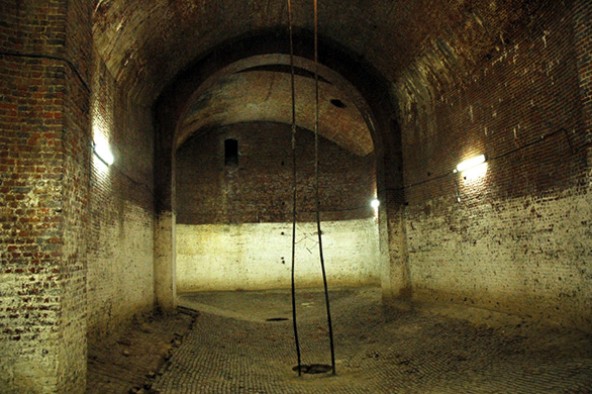
A classic ice cellar of the past © AutoCCD (Cut to size, usage according to Creative Commons Attribution-Share Alike 3.0, https://creativecommons.org/licenses/by-sa/3.0/deed.en)
While the growing demand for refrigeration resulted in increasingly sophisticated logistical solutions, and natural winter ice began to be carved out of Arctic seas, glaciers, frozen lakes and rivers and transported to far-flung markets, it remained by its very nature an ephemeral commodity that usually did not survive the summer, even behind the thickest of walls or with the use of chemicals such as saltpetre and water.
Refrigeration played a particularly important role in the production and storage of beer and wine. “A wise brewer always keeps his cellar full of ice”, advises a brewers’ and maltsters’ calendar as late as 1880. Each year, the 17 breweries in Munich (Germany) alone stockpiled 56,000 tonnes of block ice to achieve the low temperatures required for the production of especially flavoursome bottom-fermented beer.
At the same time, the desire to produce cold and ice artificially fired the imagination of many a clever inventor and technician in the early years. In 1756, Scottish physician and chemist William Cullen was the first to produce small amounts of artificial ice at the University of Glasgow by evaporating diethyl ether. It took almost another 100 years until the chemical refrigerator was developed in 1834. This appliance, however, was not suitable for private households, and so the only option available to most people was to place blocks of ice inside boxes specially lined with wood and insulating materials to create the popular “icebox”.
A breakthrough for compressor technology
German engineer and inventor Carl Paul Gottfried Linde (1842-1934), or Ritter von Linde as he was known after his knighting in 1897, was the first to break new ground in 1873 with his calculations on the efficiency of compressor technology as compared to absorption technology, which was then the prevailing method used in refrigeration and air conditioning. Professor Linde promptly founded his own company and very quickly attracted the interest of other inventors and entrepreneurs. The first to benefit were the brewers. By the 1930s, refrigerators had become a standard feature of private households in the USA.
In other parts of the world, however, refrigerators were still viewed as luxury items and symbols of prosperity and progress, and it took quite some time for the new technology to become commonplace. Refrigerators were expensive, bulky, and didn’t work without a reliable power supply. In countries like Germany, community cold stores for storing fruit, vegetables and other provisions continued to hold the advantage. It wasn’t until the 1950s that the Wirtschaftswunder (the post-war economic boom in Germany) heralded the introduction of the refrigerator into private life – daily shopping trips became a thing of the past and home cooking became increasingly varied, setting the tone for a new era of prosperity and social, economic and technological progress.
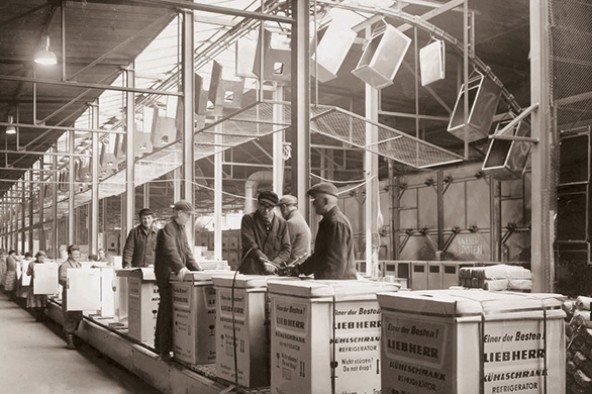
1954 Liebherr enters the refrigerator design and manufacturing business
Hans Liebherr discovers the market gap – and creates a global brand
Liebherr entered the market for designing and manufacturing refrigerators in 1954. Right from the outset, company founder Hans Liebherr focused on quality products – from the first floor-mounted appliances through to integrated refrigerators and combined fridge-freezers. As early as 1978, the specialist manufacturer began to develop refrigeration batteries, which create an additional cold reserve to maintain temperature in the event of a power failure. From innovations such as NoFrost and BioFresh (a patented technology for improved freshness) to the use of natural coolants combined with more efficient refrigeration circuits and new insulating materials, Liebherr has set and continues to set benchmarks in the industry. The company offers a wide range of models worldwide – all with top energy efficiency ratings. Energy labelling of all refrigerators and freezers in Europe has been revised as of 1 March 2021. The previous labelling system offered consumers very little help when choosing what to buy, because all the products were concentrated at the top of the scale. With the new labelling system, devices will be rated on an efficiency scale from A to G so they are more spread out, giving a clearer overview. Classifications like A+++ will no longer be used. Refrigeration technology is not just used for keeping food products cool, though. In medicine it is indispensable for laboratories, research institutions and ultra-low temperature freezers, as seen recently in the storage of new types of mRNA vaccines.
Liebherr is also involved in space technology. The company and its partners are developing key components for the technology payload and platform cooling system to actively control electronic heat dissipation on board next-generation telecommunications satellites.
Liebherr also develops energy-efficient, ecological equipment for climate control on trains, metro systems and airplanes, and for reliable transportation of goods in a temperature-controlled environment in refrigerated semitrailers. In addition, the company is developing completely new specialist applications, such as those increasingly used in electromobility to cool live high-voltage cables or batteries. Liebherr is also involved in space technology. The company and its partners are developing key components for the technology payload and platform cooling system to actively control electronic heat dissipation on board next-generation telecommunications satellites. As the evaporators and condensers will be spending at least 15 years in space without maintenance, they must be extremely reliable.
High-precision refrigeration technology is also vital when it comes to providing air-conditioning in operating theatres, intensive care units and radiological measurement facilities. The field of refrigeration and cooling technology is constantly expanding. Global sales in the non-commercial business segment alone are in the order of more than 100 billion euros, with a strong upward trend. This will lead to a corresponding intensification in the pressure to innovate. Climate change and political demands for more sustainable technologies mean that experienced and innovative developers are more in demand than ever before – people who can think outside the box in their own field and who know how to forge new links between different subjects and disciplines. The search for cold continues – Sir Francis Bacon would probably be delighted to see how many new prospects are associated with the field today.
A history of refrigeration: From cellar vaults to a pillar of progress and prosperity
Where would we be without refrigeration technology? That’s a long story. We spoke to technology historian Dr Hans-Liudger Dienel, professor at the Technical University of Berlin.
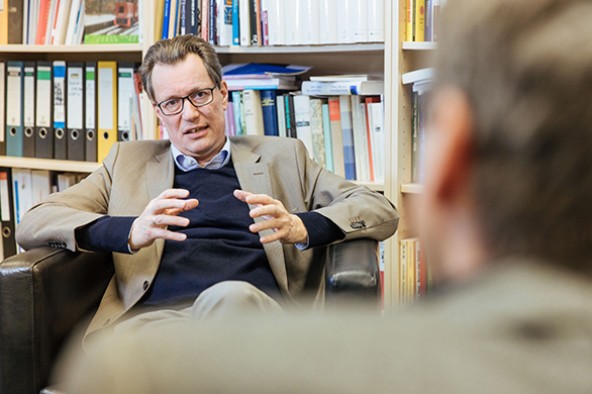
Professor Dienel, the art of making fire sparked an idea in the mind of Homo Erectus: the dream that a safer, easier and more comfortable life might be possible. What is the civilisational significance of the discovery of refrigeration?
Human beings’ use of fire, which began around 100,000 years ago, is certainly fundamentally significant. This is clearly evident in the myth of Prometheus, who by playing with fire, got into trouble with the Olympian gods, and was severely punished for his presumption. The fact that the ancient Greeks had a god of fire, Hephaestus, but no god, not even a demigod, of the cold is symptomatic of just how far the path was to the breakthrough of refrigeration technology in the 19th century. Until then, fresh foods such as meat, fish, fruit and vegetables were either consumed immediately, or served dried, cured or salted. The invention of technical refrigeration was the first step towards changing eating habits around the world, and today we can even source fresh food from other continents. While this admittedly does not come close to the importance of fire, it is nonetheless a civilisational milestone for human development on this planet.
What are the main innovative and technological milestones in the history of refrigeration from antiquity to the age of industrialisation, and who was at the forefront of each?
The ancient world was no stranger to refrigeration. At that time, people already knew that when two liquids are poured together, e.g. a saltpetre with water, an endothermic reaction occurs in which energy is consumed rather than released, thus achieving cooling effects. But this was at best limited to parties held by rich Roman patricians, and not implemented on a larger scale. The more common practice was to “harvest” snow and ice in the winter and store it in icehouses or underground. This is where the Roman’s poor grasp of thermodynamics becomes apparent. Storing ice aboveground and building a wooden hut around it would have reduced the heat loss much more than storing it underground, where heat conduction in the moist, muddy environment is far more pronounced. There was always a need for efficient cooling that could be supplied at any time, but it took hundreds of years, until the end of the 19th century, to achieve a real breakthrough in this field.
The new technological approach to refrigeration went hand in hand with the highest quality expectations right from the start, and people were always prepared to dig a little deeper into their pockets for superior quality.
Carl von Linde and his refrigeration machines ushered in a breakthrough in industrial refrigeration technology. What (visionary) ideas was he guided by and what is their significance today?
Carl von Linde’s notable achievement was to calculate the thermodynamic efficiency of existing refrigeration machine concepts for his students, thus demonstrating to them the advantages of compression technologies over the absorption technologies that were predominant at the time. The higher efficiency of the compression refrigerators, which at first was only determined theoretically, then very quickly led Linde and his staff to turn their backs on academic life and establish one of the world’s leading and most sought-after engineering firms for companies, especially breweries. However, large breweries such as Guinness and Carlsberg, for whom refrigeration machines often represented the largest single machinery investment, frequently insisted that Carl von Linde supervise the construction in person as well. The new technological approach to refrigeration went hand in hand with the highest quality expectations right from the start, and people were always prepared to dig a little deeper into their pockets for superior quality.
The first series production of refrigerators was launched in the USA. Why there and why did it take so much longer in other countries?
This is a similar situation to that of the automobile, which was first launched on the roads of Germany by Carl Benz, but didn’t become established on the market until Henry Ford began series production in the USA. Mechanical refrigeration went through a similar development. Initially, there was not enough demand for these expensive devices, which were only worked if you had uninterrupted access to electric power. For a long time, people managed perfectly well with their “iceboxes”. This was not the case in the USA. The American food system was fundamentally different from the European one; by the end of the 19th century, many aspects of it had already been fully industrialised. This is perhaps best exemplified by the large slaughterhouses in Chicago. Cattle from all across the United States were rounded up and driven to the stockyards in true Western style, butchered, and their meat distributed back across the country. This kind of industrialised food supply system paved the way for the refrigerator as a series-produced commodity. The technology was largely provided by German engineers and technicians who had emigrated to the US and set up their own companies there.
In Germany, the refrigerator didn’t really take off until the 1950s...
This was largely thanks to Hans Liebherr, who recognised the market potential in Germany’s upwardly mobile post-war society early on. The “Wirtschaftswunder” or post-war economic boom of the 1950s saw an increase in the willingness to invest in household appliances. The refrigerator became a symbol of the new prosperity. Today, the kitchen is often the most expensive feature of most middle-class homes, surpassing even the living room in terms of investment. Refrigerators, however, are becoming more and more affordable, and the rise of increasingly sophisticated technology and digitalisation has improved their price-performance ratio. Cooking computers, and sophisticated cooker, oven and cooking systems are starting to replace refrigerators as the single most expensive household item.
Professor Dr Hans-Liudger Dienel is a researcher in the field of Technology, Mobility and Participation Studies and holds the chair for Work, Technology and Participation at the Technical University of Berlin since 2013. After graduating from high school and completing an apprenticeship as a heating engineer (journeyman’s certificate), he studied Mechanical Engineering, History, Philosophy and Sociology in Hanover, Washington and Munich, obtaining a diploma in Mechanical Engineering (TU Munich, Institute of Thermodynamics) in 1990 and a PhD in 1993 with his dissertation on the reciprocal effects of higher education and industry in the United States and Germany from 1870-1930.
What role does refrigeration technology play today in the advancement of better living conditions worldwide and technological progress in industry and commerce, food supply, and medicine....?
Nowadays, smart cooling technology plays a significant role in all aspects of our lives. Some people spend a lot of time in their kitchens cooking elaborate meals with immense passion and a plethora of technical devices – others do not. In New York, the number of apartments with no kitchen is on the rise. People either eat out or order a takeaway. But everyone still has a refrigerator. It’s not just food and beverages that need cooling, however, air-conditioning in buildings is also expanding across the globe. Thriving economies in Texas, Arizona or Florida would be inconceivable without air conditioning; the same holds true for many tropical regions in Asia. High-tech products, such as chips and superconductors, could not be manufactured without the use of refrigeration and air-conditioning technology. Last but not least, super refrigerators that generate temperatures as low as -70OC have been instrumental in enabling the use of novel mRNA vaccines to combat the coronavirus pandemic in a comparatively short period of time. In other words, the history of refrigeration is not over yet. There is plenty more to come.

